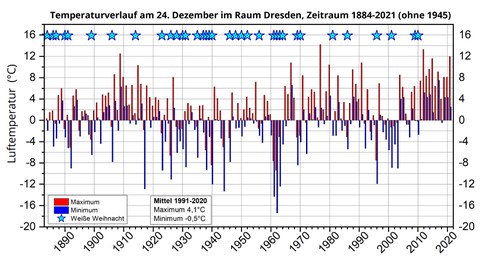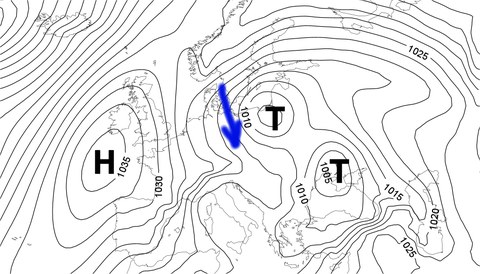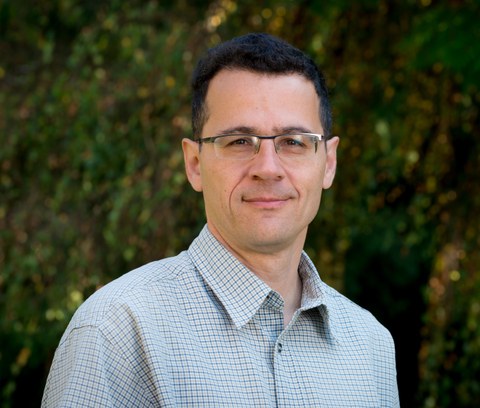Dec 05, 2022
White Christmas – never again?
Essay by Dr. Valeri Goldberg, Senior Lecturer at the Chair of Meteorology at TU Dresden
The dream of Christmas with plenty of snow is no phenomenon of modern times. Numerous historical motifs on postcards and Advent calendars and many Christmas carols bear witness to this longing of the people. But does this desire match reality? And has the weather around Christmas changed in our region, and will it continue to change?
A look at the temperature statistics for Dresden shows that the weather on Christmas Eve can vary greatly (Fig. 1). In the 137 years of observation since 1884, there have been both freezing cold with temperatures as low as minus 18 °C, as in 1962, and spring-like mildness with almost 15 °C plus, as in 1977. Exactly 35 times Dresden was covered with snow on Christmas Eve, i.e. on a statistical average, a white Christmas occurred about every fourth year. A green Christmas is thus the rule and a white Christmas the exception. There are two main reasons for this phenomenon. First, even frosty Christmas days are often free of snow. Second, the weather conditions often change shortly before Christmas. The often prevailing wintry weather period is then replaced by a weather pattern with winds from the west, which is associated with the inflow of mild Atlantic air masses. The “Christmas thaw” sets in and terminates the dream of a white Christmas.

History of the air temperature (maximum, minimum) on December 24 in the Dresden area for the period of 1884-2021, with indication of the years with a white Christmas and the averages of the 1991-2020 climate period.
Weather statistics also show that years with a white Christmas are unevenly distributed in recent climate history. For example, at the end of the 19th century and the beginning of the 20th century, there were very few white Christmases (3 in 20 years). This phenomenon may have been one of the reasons for the significant increase in Christmas motifs with snow on postcards and calendars during this period. People in the 1970s (the author's childhood years) had to do without snow at Christmas altogether.
On the other hand, there were very frequent white Christmases in the 1950s and 1960s. This may explain the grandparents' generation's rapture of reliable snow at Christmas in the past. Many of you will also remember the cold and snowy December 2010, which gave the people of Dresden and their guests a fantastic Christmas with a snow cover of 20-30 cm. Since then, we have been waiting for snow at Christmas. This now longest continuous period of years with green Christmas holidays since the weather records began suggests the impact of global warming. There is indeed a direct link between the warming of the atmosphere as well as the oceans and the decreasing frequency of white Christmases in Central Europe. The reason is the decreasing probability of snow conditions in winter. For a continuous snow cover to develop in the lowlands, the weather pattern must be such that frosty but also moist air masses from the polar region reach Central Europe. That kind of winter weather pattern at Christmas time occurred in 1986, for example (Fig. 2): Maritime arctic air was brought in between an area of low pressure over Eastern Europe and an area of high pressure over the Atlantic, leading to extensive snowfall at subzero temperatures in Saxony. As a result, there was a snow depth of 30 cm in Dresden on Christmas Eve.

Air pressure distribution (isobars - lines of equal atmospheric pressure in hPa) in Europe on December 23, 1986, 01:00 CET. Between a low-pressure area over Poland and a high-pressure area over the Irish Sea, maritime Arctic polar air flows into Central Europe, associated with heavy snowfall down to the lowlands.
However, due to the increasing warming of the Arctic in winter, the probability that the air masses reaching us from there will be sufficiently cold for precipitation in the form of snow decreases. At the same time, global warming is shifting the frequency of weather patterns in our latitudes. For example, we can observe an increase in subtropical high-pressure systems and mild southwesterly wind conditions during the winter months in Central Europe, which also decreases the frequency of snowy weather conditions in winter. In a study from last year, the German Meteorological Service shows that the occurrence of a white Christmas is clearly declining in most of Germany's regions and is now at a frequency of every 10 years. This trend is linked to the already observed increase in winter temperatures in Germany. The average winter temperature (average air temperature in the months of December-February) in Dresden has risen by about 1.2 °C over the last 60 years. Climate projections forecast a warming of winters in Central Europe by 3-4 °C for the end of the 21st century, making a white Christmas in the 2nd half of this century a very rare event.
There is still a sliver of hope. An event being very rare does not necessarily mean something is completely out of the question, and maybe the dream of a white Christmas will already come true this year.

